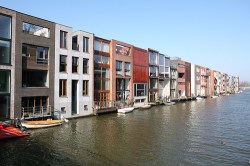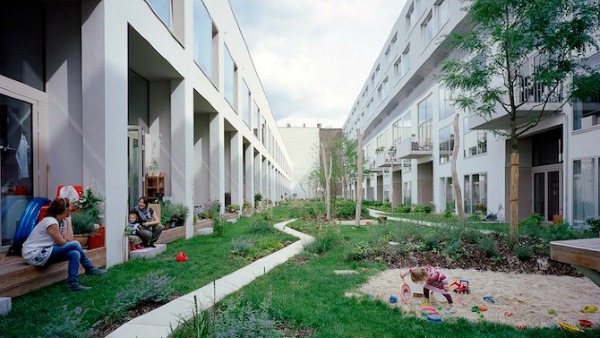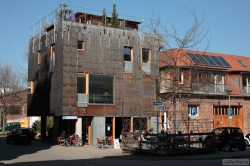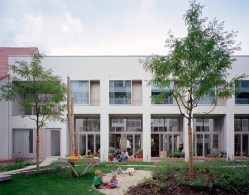
stevecadmanA baugruppe.
If you could create your perfect living situation, what would it look like?
Right now most people’s choices are limited to single-family homes, apartments, or condos. But what if the choices weren’t limited? What if you could stitch together your ideal scenario?
As a devotee of the medium chill, I think about this a lot. And here’s my own personal answer.
I want to live in a dense urban area where groceries, parks, schools, and restaurants are all within walking distance — where I can live comfortably without a car. I’d like for the district/neighborhood to be structured in such a way as to encourage casual encounters with neighbors. I’d like it to have a robust sense of community.
The building (or buildings) I lived in would be a type of cohousing, which is to say, it would be shared by a group of families who co-owned it. There would be a large common area with a big kitchen, eating space, and lounge, where families could take turns making meals for the whole group. There would be a shared outdoor area with a large garden and stuff for the kids to play on. And each family would have its own (modestly sized) unit, say, two bedrooms, two bathrooms, an office, a kitchen, and a small living room. To reach the individual units, you’d have to pass through the common area, which would encourage spontaneous socializing.
The families who lived in my building would be my friends, basically — a group of us at similar stages in our lives, with common interests and values. (This would include some childless friends, perhaps some grandparents too, just for a nice age mix.) We would share child care, tools, and time with one another. It would be an intentional community.
The building(s) would be modern in aesthetic and built to passivhaus standards, with tons of insulation, natural light, and fresh air circulation. It would have solar panels, batteries, a natural gas microgenerator, a geothermal heat-exchanger, and smart appliances, all networked together by a smart whole-home energy management system. It would create more energy than it consumes. It would have the ability to island itself from the grid in the case of emergency. And it would be located near a transit hub.
Is that too much to ask?
Ha ha, yes, of course it is.
But what if it wasn’t? What if I had the money? What if I had a group of families together, ready and willing to participate? Is there anything like this even possible?
I’ve looked at several cohousing places (primarily online, a few in person) and most of them are just a bit too far down the hippie, commune-ish side of the spectrum for me. My friends and I have idly talked about trying to buy houses on the same block, but that’s not really the same thing. Theoretically we could all buy condos in the same building, but a) it’s really difficult to find condos big enough for families, b) most condo buildings are awful, especially the common areas, c) it wouldn’t really be an intentional community, and d) it’s difficult to find truly sustainable building practices among condo developers.
What if we could build our own condo building? Well, good luck finding a developer that will customize such a project to the needs, values, and specifications of a particular group of families.
Anyway, all this was on my mind recently when I ran across a fascinating series of posts by Michael Eliason of the Brute Force Collaborative, a Seattle design firm. They are all about baugruppen, or building groups, which appear to address exactly the kinds of concerns I mention above.

zanderroth architektenBaugruppe in Prenzlauerberg.
Eliason introduces baugruppen here. The basic idea is that a group of people comes together to work directly with architects and designers, bypassing developers, to build a shared dwelling that they own collectively (a co-op, basically). Taking developers out of the picture saves money — 25 to 30 percent in Berlin, where baugruppen are common — and opens up space for much more ambitious, innovative, and sustainable architecture. It also fosters cooperation and community among members of the collective.
In this post, Eliason notes that many jurisdictions (Freiburg, Tuebingen, Hamburg, and Berlin) recognize the benefits of baugruppen and structure public policy to encourage them. “There are a number of solid reasons why cities should be interested in stimulating and facilitating such undertakings,” he says. “Jobs, affordable housing within city limits, maintaining or expanding the tax base, and stimulating development of vacant/awkwardly shaped/smaller lots developers may see as too risky are just a few.”
This post covers why baugruppen tend to save money over conventional developer-driven projects. I like this in particular:
For me, the big point on cost-effectiveness is that a member gets a unit tailored to their specific needs — as well as desired communal spaces if space and budget allows. Developers don’t normally fine-tune projects like this, as it would add even more cost and time. Additionally, development projects tend to be directed towards the average user, whom they try to appeal to, however there are some notable exceptions to this, especially here in Seattle. But before a BG even brings on an architect (assuming there isn’t one already in the group) — they’ll have discussed the type of lifestyle they would like to live, the type of building they would like to dwell in. A bunch of musically-oriented families founding a BG? They might plan a rehearsal space as part of the common area. Older couples might want a co-owned guest unit they could let their friends or children stay in, thus keeping their unit smaller and more affordable. Want a say in what color your facade is? How about typical finishes in common areas? BGs can offer that level of communal authorship.
This post is about the innovative efficiency and sustainability measures popping up in baugruppen. This one is about the wide variety of sizes and styles among them. And this one is about the communities that form around them:
There are a number of ways baugruppen are formed — some are initiated by friends or acquaintances that already share a common bond or set of core values. Others need additional members, and declare a strong central concept (bikes only! DINKS ok! Intergenerational granola-loving families!), a rallying cry for those that may be interested in joining up. …
Once formed, a large amount of community buy-in must take place. To actually build a baugruppe is no small feat. Like co-housing, the design process of many baugruppen is driven by future tenants. Concepts, themes and ideas are developed, processes are formulated to move project planning forward. The land situation must be worked out. Architects work with the owners on the design — both groups bringing needs and constraints to the table. This is not usually the case with developer-initiated projects, but on the best projects, it is this close collaboration with clients that really drives success. There has to be consensus amongst the members to move forward, schedules have to be maintained. This is a process of give and take — actual democracy in action! Though the process may take more time (e.g. weekly meetings for up to and over a year) and definitely involves challenges (There should be bike storage! The stairs should be yellow!) — it seems like a great way to engage your future neighbors while formulating a building that meets your needs in a way other models can’t or won’t. Imagine having a say in whether or not your building would have a roof terrace, or how your building engages the public! Want to implement ecological and social requirements for a project? Then do it! How about prioritizing car-free living like in Vauban? Go for it! This process seems to induce a greater sense of pride, respect and sense of community than other models — perhaps owing to the greater degree of trust and respect garnered through the planning process.
All the posts are filled with specific examples (and photos) of baugruppen. Check them out.
As Eliason says, this mostly seems to be happening in Germany (which is way ahead on community energy projects too). But it sounds like exactly the kind of thing I have in mind. And I know I can’t be the only one who dreams of sustainable urban living, with a community and a home that reflect my values.
What would it take to get these things going in the U.S.? Or at least, ahem, in Seattle? Do any of you readers have experience with them? Thoughts about the regulatory or financing barriers in the U.S.? Educate me.




